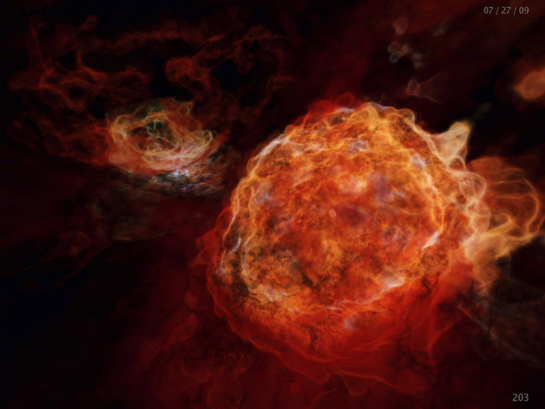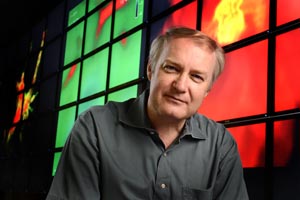 This image shows an intermediate step in visualizing the first supernova simulation for the movie. Credits: Simulations performed by the "Ranger" supercomputer at TACC. Visualization by Donna Cox and her group at NCSA. Dan Glass, visual special effects. Volker Bromm, astronomer and scientist.Astronomer Volker Bromm recently spoke to the Texas Advanced Computer Center (TACC) about his simulations of the early universe (created with the help of the supercomputers at TACC), and how they made their way into Terrence Malick's film Tree of Life.
This image shows an intermediate step in visualizing the first supernova simulation for the movie. Credits: Simulations performed by the "Ranger" supercomputer at TACC. Visualization by Donna Cox and her group at NCSA. Dan Glass, visual special effects. Volker Bromm, astronomer and scientist.Astronomer Volker Bromm recently spoke to the Texas Advanced Computer Center (TACC) about his simulations of the early universe (created with the help of the supercomputers at TACC), and how they made their way into Terrence Malick's film Tree of Life.
TACC: Can you tell us about the opportunity to work on Terrence Malick's film, Tree of Life?
Bromm: It was a bit serendipitous. I had written a popular article about the early universe in Sky and Telescope, and Terry Malick read it and then got in touch with me. I think at that point he was still in the preparatory stages of putting the movie together, and then we met, and from there this involvement developed further.
It sounds like you worked closely with Terrence Malick. Were there other people from the film that you worked with, and did they provide particular artistic direction for your part in the film?
I met with Terry twice. And then I talked to the people who were responsible for the visual effects. It was done in a two-layer process. We had our simulations done at the Texas Advanced Computing Center, and then we worked with computer scientists and visualization experts at the University of Illinois; a wonderful group headed by Professor Donna Cox. They basically took our data and made wonderful first cut visualizations. Afterwards, it was shipped to a professional visualization effects company in London. So, there were a number of steps and I talked for many hours to the people involved with the visual effects.
When I had the first meeting with Terry Malick he said that he wanted to get it right…he didn't want to just make up stuff—say you have visual effects in Star Trek or Star Wars—he wanted to do the real thing. The closest we can come is a computer simulation of the universe because at this point we cannot directly observe it; therefore, having a computer simulation is the closest thing to how it really was at that time. He wanted to tell the history of the universe with as much realism as possible. Then we translated our simulation into a visualization. The question was always—Does it look right? Does it catch the scientific idea behind it? The visual effects people were very accommodating in trying to get it right and to make me happy.
Was this your first time doing work for a feature film?
Yes, I had done very small scale stuff before but this was the first really big project where I was involved.
How was your experience doing this work for a feature film versus doing work for what you would normally do it for which is theory, experimentation, or new discoveries?
It was different, but also not. We are scientists but we are funded by tax payer money. For example, the simulation work was funded by the National Science Foundation, and when you have an NSF grant you are under a mandate to engage in public outreach. I wrote popular articles in Scientific American and Sky and Telescope that reach a nice audience, but it was clear to me that getting the science onto the big movie screen is a wonderful multiplier—it was a win-win situation. The movie people have commercial interest and artistic interest and their own agenda, but it nicely resonated with our interest as scientists making our work relevant for the public and making it understandable. When you do theoretical astrophysics it's very abstract, so of course there's nothing that can beat a beautiful visualization. When you kick into this mode it's a standard way to tell this story to a broad audience.
 Volker Bromm, Associate Professor in the Department of Astronomy, The University of Texas at Austin. Photo taken at the Texas Advanced Computing Center's Visualization Lab on UT Austin's main campus.
Volker Bromm, Associate Professor in the Department of Astronomy, The University of Texas at Austin. Photo taken at the Texas Advanced Computing Center's Visualization Lab on UT Austin's main campus.
How many images did you produce for this film, and how do they relate to the story line?
In the end we produced a lot of computer frames showing one particular time in the history of the universe. The simulation is about the moment of first light. We live in a universe where a few million years after the Big Bang the universe would have been completely dark—what we call the cosmic dark ages. And then for a 100 million years or so there was no source of light in the universe whatsoever. Then at some point, gravity slowly amplified little regions of the universe to condense them to enable the formations of the first stars.
Then, a dramatic transformation happened…we transcended from this primordial darkness. We had the first very bright stars…they illuminated their immediate surroundings and, eventually, at the moment of their death they exploded in very energetic, very strong, very powerful supernova explosions. It's a very metaphysical moment— it was a long period of boring, almost depressing darkness and then suddenly activity explodes, kicks in. This resonated with the story line that the movie wanted to tell. What did the universe have to go through to eventually enable intelligent beings like us with our emotional life? It's this very long cosmic timeline that led to it. The moment of first light has a very special place.
Have you seen the movie?
I did, and I was impressed. I think it's a masterpiece. Of course, it was also recognized by the professional critics. It won the Cannes Palme d'Or award. For me, it was a wonderful way to depict that we are all children of the universe. We are very limited in time and space, but through our minds we are connecting to the universe on the largest scale through its history—a microcosm and macrocosm are one. I think this [the visualization sequence] is a very unique way that this movie tries to express that.
You've been working with the Texas Advanced Computing Center for many years. How did TACC assist with your work for this film?
Without TACC none of this work would have been possible. Supercomputing technology like the Ranger supercomputer at TACC really allows us to do very remarkable things. We start with the box that represents the entire universe and then we put in all of the known laws of physics, and then we get to the point where the original stars form, and this is all done from first principles. Five years ago this could not have been done. It's a remarkable feat of supercomputer technology. I have personally seen computing and supercomputing at many places in different countries and continents. I'm incredibly impressed and grateful to TACC. It's a very good institution and having access to its resources allows me to do great science.
What do you value most about working and living in the 21st century where you have advanced computing at your side?
Well, you can now address and ask big questions. To answer them you have to address a humongous degree of complexity, and this complexity needs to be addressed with powerful machinery— we knew that this eventually would be possible. Now that we have this technology, it's remarkable the kind of realism we can create with a computer.
There are two sides to this in astronomy: we have the computers that allow us to make unprecedented predictions in very great physical detail. On the other hand, the engineers, the builders of telescopes, they also push technology and push the ability to observe earlier and earlier times in the history of the universe.
The computer is a time machine that allows us to go forward in time and the telescope allows us probe backward in time, and at some point we have this moment of overlap. You can test the theories of how the early universe is shaped and what processes transformed the universe in this remarkable way at the moment of first light.
What do you think the future of astronomy will look like in 5-10 years with the use of greater technologies as they become available?
We live in a universe where things started simple, and then with time you combine the simple building blocks to every increasing complexity. In astronomy we want to understand how to build an entire galaxy, like the Milky Way, our home galaxy. You want to build the Milky Way step by step and follow its build up through cosmic time. This is the Holy Grail of supercomputing—it's a very demanding calculation. We're putting the pieces into place and in 5-10 years we'll be able to do this.
What would you like to say to people who haven't seen the film yet?
It's a masterpiece; it's a remarkable movie. When you experience the sequence of going through cosmic time from the moments of the Big Bang to the creation of Earth and living beings, it makes you really think and it makes you appreciate the gift to be alive. I think you will leave a happier and more thoughtful person.


















Comments